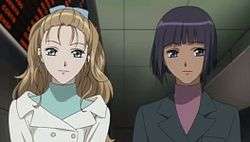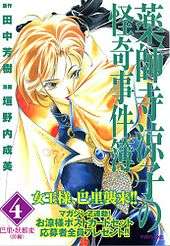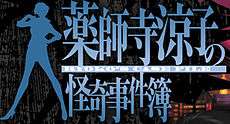Yakushiji Ryōko no Kaiki Jikenbo
| Yakushiji Ryōko no Kaiki Jikenbo | |
|
Yakushiji Ryōko no Kaiki Jikenbo title | |
| 薬師寺涼子の怪奇事件簿 | |
|---|---|
| Genre | Action, Crime, Detective Fiction, Horror, Mystery, Science Fiction |
| Light novel | |
| Written by | Yoshiki Tanaka |
| Illustrated by | Narumi Kakinouchi |
| Published by | Kodansha |
| Original run | October 5, 1998 – December 12, 2007 |
| Volumes | 8 |
| Manga | |
| Written by | Yoshiki Tanaka |
| Illustrated by | Narumi Kakinouchi |
| Published by | Kodansha |
| Demographic | Seinen |
| Magazine |
Magazine Z (Former)[1][2] Afternoon[3] |
| Original run | July 23, 2004 – January 23, 2009 |
| Volumes | 11 |
| Anime television series | |
| Directed by | Tarō Iwasaki |
| Studio | Dogakobo |
| Network | tvk, CTC, TVS, SUN, Tokyo MX, TVA, KBS, BS11, Kids Station |
| Original run | July 5, 2008 – September 27, 2008 |
| Episodes | 13 |
Yakushiji Ryōko no Kaiki Jikenbo (Japanese: 薬師寺涼子の怪奇事件簿, lit. "Ryōko Yakushiji's Strange Case Files") is a series that consist of the anime TV series, manga and light novels created by Yoshiki Tanaka and illustrated by Narumi Kakinouchi. Two Drama CDs had also been released prior to the anime adaptation with different voice actors from the CD and the TV version.
The series centers around Ryōko Yakushiji, an elite police officer with the Tokyo Metropolitan Police Department who had graduated from Tokyo University under its Law Faculty. She is involved with her subordinate Junichirō Izumida as they investigate cases that pertain to the paranormal and supernatural when and if they cannot be investigated with modern science.
As the light novels/manga adaptation and the anime have different plots and paranormal events/creatures, their central plots are most of the time different from each other.Note 1
Plot
Ryōko Yakushiji, a Superintendent in the Tokyo Metropolitan Police Department and a graduate of Tokyo University's Law Faculty and a multilingual person, works with Junichirō Izumida to investigate seemingly paranormal, supernatural or bizarre events that get involved in criminal cases. Ryōko works with her colleagues and subordinates, including her rival Yukiko Muromachi, alongside JACES security forces personnel and her personal maids Lucienne and Marianne to resolve the cases before they go out of hand.
Organizations
JACES
Owned by the Yakushiji family, it's a security company that ex-police officers both enlisted and high-ranking are employed into after their retirement.[4] JACES is well known as one of Asia's best security companies,[5] with its main headquarters located in Akasaka.[6] The company's official slogan is "Safety".[5] Its personnel use gray for their uniform color.[4]
In combat operations, they use PASGT ballistic helmets, gray BDUs, tactical vests and light to medium body armor.[4] JACES personnel are armed with expandable baton sticks when they encounter unarmed people.[4]
Its origins are traced back to the end of World War II when the Japanese Empire Security Service was established before it became JACES, which was supposed to be used for the basis of a restructured Japanese military before Ruriko went to create the JPP instead.[7]
Japan Private Police
Known as the Nippon Private Police (日本私用警察 Nihonshiyokeisatsu),Note 2 it was founded by ex-Diet member Ryojin Tadomura and heavily funded by the Government of Japan to counter the influence of JACES in the domestic and international security market.[8] They are known to be hired in war-torn countries after military forces are pulled back, conducting police duties in their place.[9] JPP personnel are also hired as private security guards. JPP uses green as its color as evident in their uniforms.[9] Unlike JACES, where most of its manpower comes from ex-law enforcement personnel, JPP recruits its personnel mostly from ex-SDF personnel.[10]
During combat operations, JPP personnel are identified with green heavy body armor, anti-riot helmets and are armed with mostly Howa Type 89 assault rifles, Heckler & Koch MP5 and Minebea PM-9 submachine guns with expandable baton sticks.[6][8][9][11] In normal operations, JPP personnel operate as private guards and sometimes, deploy robot droids to help them conduct searches and patrols with/for them.[8]
The JPP are not mentioned in the light novel/manga adaptation.
Shiba
Located in the Greater Tokyo Area, Shiba (芝) is said to house several departments of the Tokyo Metropolitan Police Department that operate under secret circumstances for covert missions.[12]
It takes its name from the Shiba district of Tokyo's Minato ward.
Characters

Main
Ryōko Yakushiji (薬師寺 涼子 Yakushiji Ryōko)
- Voiced by: Hitomi Nabatame (TV)[13]
- Voiced by: Tomoko Kawakami (Drama CD)
- An officer in the Tokyo Metropolitan Police Department's Criminal Investigation Bureau who had graduated from Tokyo University's Law Faculty, she can speak in several languages including French. Her father, Hiroki Yakushiji, is the head of the multinational security company JACES.[13] Her rank is Superintendent and the supervisor of Junichirō Izumida. She is quite an adept fighter, be it with firearms or bare hands. She is very attractive and fashionable and has never been seen wearing the same clothes twice. Ryōko doesn't hesistate to use JACES assets if necessary to help her in her work. She is called Oryo by Yukiko. She's 27 years old.[14] Ryōko is next in line to be the next JACES president. Has an older sister named Kinuko Yakushiji. She likes his superior Junichiro Izumida and often hints it through her actions seen in her attempt to always bring him along with her in almost every place she goes. Even during Junichiro's day off, she finds ways to spend time with him even though he is dense not to notice her feelings for him. Most of the police officers, high-ranking government officials and media practitioners fear not only her influence and power but her strong personality as well. Police officers go to JACES once they retire so her colleagues in the police force do not dare to oppose in fear that they will have no job after they leave the police. Ryoko also knows the secrets of high-ranking government officials so they never cross her.
- Her grandfather, Masamoto Yakushiji, was the founder of the Japanese Empire Security Service, which was the predecessor to JACES.
Junichirō Izumida (泉田 準一郎 Izumida Junichirō)
- Voiced by: Hidenobu Kiuchi (TV)[13]
- Voiced by: Kazuhiko Inoue (Drama CD)
- A non-career police officer with the rank of Assistant Inspector, he is assigned under Ryōko Yakushiji.[13] He is very submissive perhaps as a result of always being around Ryoko who has a very bossy personality. However he can be assertive and aggressive when the situation calls for it. Junichiro is very caring and kind to the people close to him shown in his attempts to advice her superior and Yukiko to always be careful. Unknown to him, Ryōko is infatuated with him and has tried to get his attention. Ryoko notes that he is dense not to notice her feelings for him. Though he is burdened by Ryoko's attitude, he stays loyal to her and tries his best to protect her. Like his superior, Izumida can fight with either firearms or with bare hands and feet. He's 33 years old.[14]
- He is also the narrator for the entire series.[13]
Yukiko Muromachi (室町 由紀子 Muromachi Yukiko)
- Voiced by: Hōko Kuwashima (TV)[13]
- Voiced by: Yuriko Fuchizaki (Drama CD)
- A rival of Ryōko since their college days, she is also a Superintendent in the Tokyo Metropolitan Police Department based at the Security Bureau. Her subordinate is Akira Kishimoto. Being the daughter of a former career police officer,[13] she refuses to use her family ties to help her in her Superintendent duties. Ryōko calls her Oyuki.
- She is also 27 years old like Ryōko.[14]
Akira Kishimoto (岸本 明 Kishimoto Akira)
- Voiced by: Kenji Nojima (TV)[13]
- Voiced by: Yūji Ueda (Drama CD)
- He is also an officer like Izumida with the rank of Assistant Inspector under Muromachi,[13] but he also happens to be an anime/manga otaku and looks up to Ryōko. He's 23 years old.[14]
Allies

Satomi Kaizuka (貝塚 さとみ Kaizuka Satomi)
- Voiced by: Misato Fukuen
- A uniformed officer in the Tokyo Metropolitan Police Department, she is responsible for mostly handling clerical works under Ryōko. She is 21 years old.
Mario Abe (阿部 真理夫 Abe Mario)
- Voiced by: Otoya Kawano
- A colleague of Ryōko and Izumida's and a uniformed officer alongside Satomi. He is 29 years old.
Maruoka (丸岡)
- Voiced by: Minoru Inaba (TV)
- Voiced by: Takkō Ishimori (Drama CD)
- An old man who is a detective under Ryoko with the rank of Inspector. He is 50 years old.

Lucienne (リュシエンヌ)
- Voiced by: Christelle Ciari[13]
- One of Ryōko's maids from France. A blonde-haired girl, she is an expert in hacking though she can handle firearms.[13]
Marianne (マリアンヌ)
- Voiced by: Satomi Satō[13]
- Another of Ryōko's maids from France. A short black-haired girl, she is an expert in handling all kinds of small arms.[13]
Yakushiji Family
Kinuko Yakushiji (薬師寺 絹子 Yakushiji Kinuko)
- Voiced by: Mie Sonozaki
- An older sister of Ryoko's. Ryōko calls her Okinu. She's 29 years old.
Hiroki Yakushiji (薬師寺 弘毅 Yakushiji Hiroki)
- Father of Ryoko and Kinuko. Nothing is known about him, except that he is the head of the JACES security company and an ex-MPD high-ranking officer. He is 60 years old.
Masamoto Yakushiji (薬師寺 正基 Yakushiji Masamoto)
- Voiced by: Atsushi Ono
- The main founder of the Japanese Empire Security Service, known as JACES in modern times, and grandfather of Kinuko and Ryoko Yakushiji.
Antagonists
Ruriko Isurugi (石動 瑠璃子 Isurugi Ruriko)
- Voiced by: Sumi Shimamoto
- A woman who has influence within Shiba. She appears to know Ryoko on a personal basis. She is also the true head of the Japan Private Police. Ruriko is seemingly ageless, having been alive after through World War II and was a co-founder of the Japanese Empire Security Service with Ryoko's grandfather Masamoto Yakushiji before she diverged and created JPP originally with the intent of reestablishing a "true" Japanese military using a security company as a cover.
- Ruriko does not appear in the light novel/manga adaptation.
Kazuma Nonagase (野長瀬 一馬 Nonagase Kazuma)
- Voiced by: Daisuke Hirakawa
- An aide to Ryoko in JACES, he is also a double agent working on behalf of JPP. He does not appear in the light novel/manga adaptation.
Others
Monami (もなみ)
- Voiced by: Hitomi Nabatame
- Merely a perfect copy of the original Ryōko Yakushiji based on her DNA after failing Hangon and modern cloning procedures twice, she was being used by Ruriko as a means of taking control of JACES from the entire Yakushiji family. Over time, Monami decides to join with Ryōko due to her feelings for Junichiro. Her name, originally means "My friend" in (French: mon ami), is given by Ryōko when Junichiro misunderstands Marianne and Lucienne's pronunciation. She is known to the JPP as R-9.[10]
- At the end of the series, she was seen placed under Ryōko's custody and even has Marianne and Lucienne keep an eye on her while going to school together in France.
- Monami does not appear in the light novel/manga adaptation.
Rogues
The following are rogues monsters/creatures that have appeared in the anime:[15]
- Giant Snake
- Making its appearance in the Babylon building in Ginza, it was created as a result of ingesting various growth hormones. It died when the building was destroyed in an explosion.
- Wisps
- It's not known how they appeared, but they had apparently showed up in the digital copies of the journalists' cameras.
- Unknown Alpha Human
- Created as a result of combining human sperm/egg cells with DNA from an unknown prehistoric human, it resulted in the creation of a monstrous alpha human that killed several yakuza assassins before it would die of rapid cell degeneration.
- Centipede Robot
- A counter-terrorist robot created by the JPP, it went rogue after a traffic accident result in an altercation of its defense systems that recognizes anyone with a dangerous object as an enemy. Ryoko defeats it by shooting its main sensor. It was later used by the JPP as a means of eliminating Ryoko and Junichiro.
- Mutant Mangrove Seeds
- Said to be caused by secret experiments of JPP scientists, they were able to possess Ryojin Tadomura and a faction of the JPP before Marianne destroys the mutant mangrove tree with napalm grenades.
- Unknown Cricket
- Discovered by an unknown person, this species has the ability to resonate sound waves that are equal or greater than the sound waves on cellphones. This results in making people commit suicide when they use their cellphones at the same time the crickets resonate the said sound waves at the same time.
Media
Light Novel
The light novel series had first started in 1996 with 8 volumes in circulation. Kodansha has the publication rights on the series and published all bunko editions, but other publishers also published some volumes borrowing the rights by Kodansha.
Bibliography
The following have been published as part of the light novels written by Dr. Yoshiki Tanaka:[16][17][18][19][20][21][22][23][24][25][26][27]
| Japanese Title | English Title | Year | First publisher | ISBN |
| 魔天楼 (Matenrō) | Demon Skyscraper | 1996 | Kodansha Bunko | ISBN 4-06-263346-9 |
| 東京ナイトメア (Tokyo Nightmare) | Tokyo Nightmare | 1999 | Kodansha Novels | ISBN 4-06-182042-7 |
| 巴里・妖都変 (Paris Yōto-hen) | Paris, The Strange Attractive Capital | 2000 | Kobunsha Kappa Novels | ISBN 4-334-07371-9 |
| クレオパトラの葬送 (Cleopatra no Sōsō) | Funeral of the Cleopatra | 2001 | Kodansha Novels | ISBN 4-06-182197-0 |
| 黒蜘蛛島 (Kuro Kumo Shima) | Black Spider Island | 2003 | Kobunsha Kappa Novels | ISBN 4-334-07541-X |
| 夜光曲 (Yakōkyoku) | Luminous Song | 2005 | Shodensha Non-Novels | ISBN 4-396-20793-X |
| 霧の訪問者 (Kiri no Hōmonsha) | Visitor's Fog | 2006 | Kodansha Novels | ISBN 4-06-182499-6 |
| 水妖日にご用心 (Suiyō-bi ni Goyōjin) | Be Careful on Wednesday | 2007 | Shodensha Non-Novels | ISBN 4-396-20840-5 |
Drama CD
Two drama CDs were put on the market by Avex in 1999 (Tokyo Nightmare)[28] and 2001 (Matenrō).[29] The cast was different from the later anime version.
Manga

The manga first started on July 23, 2004 under Kodansha's seinen manga magazine Magazine Z. It had been printed with 11 volumes released. Following the dissolution of Magazine Z, the serialization of Yakushiji Ryōko no Kaiki Jikenbo was continued by Afternoon.[3] It is serialized in Japan under Kodansha.[30] In Taiwan, it is published by Sharp Point Press as 藥師寺涼子怪奇事件簿.[31]
Three spin-off manga were also created by Yoshiki Tanaka and Narumi Kakinouchi. The first was SP - Yakushiji Ryōko no Kaiki Jikenbo Tanpenshuu (SP 薬師寺涼子の怪奇事件簿 短編集), published in one volume on June 17, 2008 by Kodansha for 600 yen[32] with another volume released on May 23, 2011[33] with the final volume released on November 22, 2011.[34] Two volumes of Yakushiji Ryōko no Kaiki Jikenbo - Kiri no Houmonsha (薬師寺涼子の怪奇事件簿 霧の訪問者) soon followed, published on September 23, 2009 and January 22, 2010 for 590 yen.[35][36] Another spin-off was called Yakushiji Ryōko no Kaiki Jikenbo - Suiyobi ni Goyojin (薬師寺涼子の怪奇事件簿 水妖日にご用心) with volumes released on June 23, 2010 and November 22, 2011 for 590 yen.[37][38]
Artbook
An artbook released with drawings related to the manga series called Flawless Yakushiji Ryōko no Kaiki Jikenbo Irasuto-shū (Flawless 薬師寺涼子の怪奇事件簿イラスト集 Flawless Ryōko Yakushiji's Strange Case Files Illustrations) was released by Kodansha on August 28, 2006 for 2,100 yen.[39]
Anime
An anime version of Yakushiji Ryōko no Kaiki Jikenbo had aired on July 5, 2008 with 13 episodes broadcast,[40] with animation done by Dogakobo.[41] A DVD version is scheduled for release on September 26, 2008 with 3 episodes each.[42] Other releases include October 22, December 25 of 2008 and January 21, 2009.[42]
The series had been previously broadcast at the BS11 Digital, Chiba TV, KBS Kyoto, Sun TV, Tokyo MX TV, TV Aichi, Television Saitama and TVK television stations.[13][43][44]
The opening theme is Thème principal by KATSU (angela). The ending themes are various through series: À demain sur la lune (#1,3), Ryoko 2 (#2,6), Songe d'une nuit d'été (#4,7,9,10,12), La Vie en rose (#5), Le combat (#8,11) by KATSU (angela), and Thème principal La chanson d'atsuko by atskuko (voice) and KATSU (music).
Streaming
Yakushiji Ryōko no Kaiki Jikenbo is also available via broadband access streaming.[45] However, it is only accessible if the user is based from Japan.
OST
A BGM OST, Volume 1 with music from the show was released on June 4, 2008 with 8 tracks.[46] The second volume had been released on August 6, 2008 with 17 tracks[46] with a third OST on September 10, 2008 with 13 tracks.[46] All three OSTs have the title Le recueil des faits improbables de Ryōko Yakushiji, which is the show's title in French, and the most of composition are also named in French.
Development
Announcements regarding the animation of Yakushiji Ryōko no Kaiki Jikenbo came in 2007 regarding its adaptation for television for 2008.[47]
Promotion
To promote the show, the cast and Yoshiki Tanaka went on a tour in Tokyo, Nagoya and Osaka[48][49] with them telling about their experiences and their thoughts on the show.[48]
Events was held on July 26, 2008 in Nagoya, July 27, 2008 and August 3, 2008 in Tokyo to promote the show, starring the main cast including Hitomi Nabatama and Hidenobu Kiuchi with Yoshiki Tanaka.[13] They held screenings of Yakushiji Ryōko no Kaiki Jikenbo for those who won passes by submitting their postcards with draws held on July 4, 2008.[13]
Reception
Dengeki Online places Yakushiji Ryōko no Kaiki Jikenbo on 7th place out of 10 news weekly events for June 1, 2008.[50]
References
- ↑ "Magazine Z, Comi Di Gi+ Manga Mags Ending in Japan". Anime News Network. 2008-09-03. Retrieved 2009-03-16.
- ↑ "講談社 月刊マンガ誌「マガジンZ」の休刊を発表" (in Japanese). 2008-09-02. Retrieved 2009-03-16.
- 1 2 "5 Manga to Continue after Magazine Z's End". Anime News Network. 2009-01-26. Retrieved 2009-03-16.
- 1 2 3 4 Taro Iwasaki (2008-07-19). "The Sakuradamon Incident". Yakushiji Ryōko no Kaiki Jikenbo (in Japanese).
- 1 2 Taro Iwasaki (2008-07-12). "Ginza Crime Tower (2nd part)". Yakushiji Ryōko no Kaiki Jikenbo (in Japanese).
- 1 2 Taro Iwasaki (2008-09-27). "Tokyo Dead or Love (2nd Part)". Yakushiji Ryōko no Kaiki Jikenbo (in Japanese).
- ↑ Taro Iwasaki (2008-09-06). "Takanawa Princess". Yakushiji Ryōko no Kaiki Jikenbo (in Japanese).
- 1 2 3 Taro Iwasaki (2008-08-16). "Okinawa, Kounoshima". Yakushiji Ryōko no Kaiki Jikenbo (in Japanese).
- 1 2 3 Taro Iwasaki (2008-08-02). "The Bug That Crawls the Omotesando". Yakushiji Ryōko no Kaiki Jikenbo (in Japanese).
- 1 2 Taro Iwasaki (2008-09-06). "Linen Trap". Yakushiji Ryōko no Kaiki Jikenbo (in Japanese).
- ↑ Taro Iwasaki (2008-09-20). "Tokyo Dead or Love (1st Part)". Yakushiji Ryōko no Kaiki Jikenbo (in Japanese).
- ↑ Taro Iwasaki (2008-08-30). "Queen of Shiba". Yakushiji Ryōko no Kaiki Jikenbo (in Japanese).
- 1 2 3 4 5 6 7 8 9 10 11 12 13 14 15 16 "「ドラ寄せお涼」がアニメに登場! 「薬師寺涼子の怪奇事件簿」7月より放送開始". Dengeki Online. 2008-06-04. Retrieved 2010-03-30.
- 1 2 3 4 "Yakushiji Ryōko no Kaiki Jikenbo's Characters Page, Yakushiji Ryōko no Kaiki Jikenbo's Starchild Page" (in Japanese). Retrieved 2009-03-16.
- ↑ "Yakushiji Ryōko no Kaiki Jikenbo's Monster Page, Yakushiji Ryōko no Kaiki Jikenbo's Starchild Page" (in Japanese). Retrieved 2009-03-16.
- ↑ "魔天楼 (Original)" (in Japanese). Kodansha. Retrieved 2012-02-17.
- ↑ "魔天楼 (Republished)" (in Japanese). Kodansha. Retrieved 2012-02-17.
- ↑ "東京ナイトメア (Original)" (in Japanese). Kodansha. Retrieved 2012-02-17.
- ↑ "東京ナイトメア (Republished)" (in Japanese). Kodansha. Retrieved 2012-02-17.
- ↑ 巴里・妖都変 (in Japanese). Kodansha. Retrieved 2012-02-17.
- ↑ "クレオパトラの葬送 (Original)" (in Japanese). Kodansha. Retrieved 2012-02-17.
- ↑ "クレオパトラの葬送 (Republished)" (in Japanese). Kodansha. Retrieved 2012-02-17.
- ↑ 黒蜘蛛島 (in Japanese). Kodansha. Retrieved 2012-02-17.
- ↑ 夜光曲 (in Japanese). Kodansha. Retrieved 2012-02-17.
- ↑ 霧の訪問者 (in Japanese). Kodansha. Retrieved 2012-02-17.
- ↑ 霧の訪問者 (in Japanese). Kodansha. Retrieved 2012-02-17.
- ↑ 水妖日にご用心 (in Japanese). Kodansha. Retrieved 2012-02-17.
- ↑ "Amazon Japan's Tokyo Nightmare Drama CD" (in Japanese). Amazon Japan. Retrieved 2009-03-16.
- ↑ "Matenrou - Ryoko's Case File (Yakushiji Ryoko no Kaiki Jikenbo) Drama CD" (in Japanese). Retrieved 2009-03-16.
- ↑ "Yakushiji Ryōko no Kaiki Jikenbo, Volume 1" (in Japanese). Kodansha Japan. Retrieved 2012-02-15.
- ↑ "Yakushiji Ryōko no Kaiki Jikenbo, Volume 1" (in Chinese). Sharp Point Press. Retrieved 2012-02-15.
- ↑ "SP 薬師寺涼子の怪奇事件簿 短編集" (in Japanese). Kodansha. Retrieved 2010-03-30.
- ↑ "SP2 薬師寺涼子の怪奇事件簿 短編集" (in Japanese). Kodansha. Retrieved 2012-02-17.
- ↑ "SP3 薬師寺涼子の怪奇事件簿 短編集" (in Japanese). Kodansha. Retrieved 2012-02-17.
- ↑ 薬師寺涼子の怪奇事件簿 霧の訪問者(上) (in Japanese). Kodansha. Retrieved 2010-03-30.
- ↑ 薬師寺涼子の怪奇事件簿 霧の訪問者(下) (in Japanese). Kodansha. Retrieved 2010-03-30.
- ↑ 薬師寺涼子の怪奇事件簿 水妖日にご用心(上) (in Japanese). Kodansha. Retrieved 2012-02-17.
- ↑ 薬師寺涼子の怪奇事件簿 水妖日にご用心(下) (in Japanese). Kodansha. Retrieved 2012-02-17.
- ↑ "Flawless 薬師寺涼子の怪奇事件簿イラスト集". Kodansha. Retrieved 2012-02-17.
- ↑ "Tokyo MX's Yakushiji Ryōko no Kaiki Jikenbo episode guide" (in Japanese). Retrieved 2009-03-16.
- ↑ "Dogakobo Studio's Official Yakushiji Ryōko no Kaiki Jikenbo Production Page" (in Japanese). Retrieved 2010-03-28.
- 1 2 "Yakushiji Ryōko no Kaiki Jikenbo's DVD Page, Yakushiji Ryōko no Kaiki Jikenbo's Starchild Page" (in Japanese). Retrieved 2009-03-16.
- ↑ "Yakushiji Ryōko no Kaiki Jikenbo's On Air Schedule Page, Yakushiji Ryōko no Kaiki Jikenbo's Starchild Page" (in Japanese). Retrieved 2009-03-16.
- ↑ 薬師寺涼子の怪奇事件簿 (in Japanese). Retrieved 2010-03-26.
- ↑ "Bandai Channel's Yakushiji Ryōko no Kaiki Jikenbo page" (in Japanese). Bandai Channel. Retrieved 2012-02-14.
- 1 2 3 "Yakushiji Ryōko no Kaiki Jikenbo's CD Page, Yakushiji Ryōko no Kaiki Jikenbo's Starchild Page" (in Japanese). Retrieved 2009-03-16.
- ↑ "Galactic Heroes Author Does Yakushiji Mystery TV Anime (Updated)". 2007-12-13. Retrieved 2008-08-10.
- 1 2 薬師寺イベントオフィシャルレポ (in Japanese). Retrieved 2009-03-16.
- ↑ 「薬師寺涼子の怪奇事件簿」アニメ化記念イベントについて (in Japanese). Retrieved 2009-03-16.
- ↑ "【6月1週・Newsランキング】今週はゲームが健闘しておりますよ" (in Japanese). Dengeki Online. 2008-06-09. Retrieved 2010-03-26.
Notes
- ^ Some of the storylines in the manga serialization are based on the light novels such as the Black Spider story arc
- ^ The JPP is also known as the Japanese Private Police as mentioned by Ryoko in the episode "Okinawa, Kounoshima".
External links
- Starchild's Official Site (Japanese)
- Tokyo MX's Official Site (Japanese)
- Yakushiji Ryōko no Kaiki Jikenbo (anime) at Anime News Network's encyclopedia
- Yakushiji Ryōko no Kaiki Jikenbo (manga) at Anime News Network's encyclopedia
